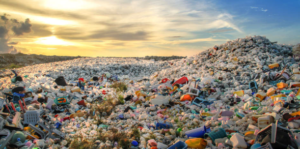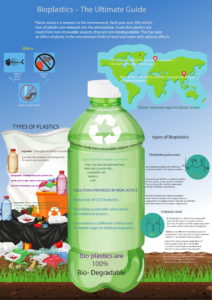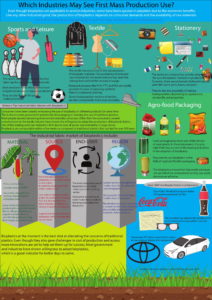American Made, Iron Clad Protected - Discover the Industries Best Warranty.
Blog
BioPlastics – The Ultimate Guide – When Will it Be Mainstream
 Plastic waste is a menace to the environment. Each year over 300 million tons of plastics are released into the atmosphere. Given that plastics are made from non-renewable sources, they are non-biodegradable. This has seen an influx of plastic in the environment both on land and water with adverse effects.
Plastic waste is a menace to the environment. Each year over 300 million tons of plastics are released into the atmosphere. Given that plastics are made from non-renewable sources, they are non-biodegradable. This has seen an influx of plastic in the environment both on land and water with adverse effects.
Some of the effects of plastics in the environment are the death of marine species and fowls. They jam sewerage systems and cause flooding. Besides, they cause severe environmental concerns like garbage patches. It is for these reasons why most governments are putting in place regulations to curb the use of regular plastics.
Most of the Asian Pacific countries have banned the use of traditional plastics. The EU government has put in place regulations like taxation to help reduce usage.
With all these disadvantages, plastics have several essential uses that must keep on for human life. That is where the bioplastics come in.
Bioplastics are the 100% degradable, versatile, and equally resistant replacement for the traditional plastics. They are used in a wide variety of industries and applications. Already they are becoming a hit in most countries around the world. This guide seeks to give you all the critical information about bioplastics.
Before you get to learn more about bioplastics, you need to understand some of the most common yet confusing terms;
Degradable – This implies the ability to break down over time into powder or small fragments. All plastics are degradable.
Biodegradable – A biodegradable plastic can break down entirely under the right conditions. Most plastics are broken down into carbon dioxide, water, and compost.
Compostable – This is when plastic can break down in a compost environment.It involves breaking down without leaving any toxic residue or release carbon dioxide in the background.
What are Bioplastics?
Anytime you see the term “bio,” in a word, you are predisposed to get the idea that the product is useful both for the environment and the user. But are bioplastics really as environmentally friendly as is portrayed?
Bioplastics are any plastics materials made from renewable organic materials like corn starch. Bioplastics can also be derived from biomass sources like vegetable oils, tapioca, and milk.
Some of the problems Bioplastics seek to solve include;
· Reduction of CO2 footprint.
· Providing sustainable alternatives to traditional plastics.
· Innovations as different entities look for better ways of utilizing bioplastics.
There are two main types of Bioplastics:
· PHA (Polyhydroxyalkanoate)
These are made by microorganisms that are genetically engineered to produce plastics from organic materials. The process involves starving the microorganism of nutrients like nitrogen, oxygen, and carbon. The microorganisms disintegrate into carbon granules with the same chemical properties of traditional plastics.
The primary use of PHA is in medical products like bone plates, slings, and skin substitutes. They are degradable, readily compostable, and safe for human consumption.
The PHA can withstand high temperatures, which makes it great for several applications as compared to the regular plastics. They also provide high ultraviolet resistance to hydrolytic degradation.
· PLA (Polylactic Acid)
PLA bioplastics are derived from renewable resources like sugar cane and corn starch. Currently, PLA has one of the highest production rates among all the other types of bioplastics. They are relatively cost-efficient to produce as you can manufacture them using the existing equipment meant for making other industry plastics.
Some of the most common applications of PLA are plastic mulch films and bottles. It constricts under high temperatures that allow for its use as shrink wrap materials. They also melt quickly, which makes it suitable to use in 3D printing as a filament. The versatility and ease of degradation of PLA have made it a good option for bioplastics. As of 2019 we are still waiting to see a flame retardant alternative that could be used in a product like PLA Body Shop Curtains, PLA Vinyl Tarps and PLA Industrial Curtain Walls.
Which Industries May See First Mass Production Use?
Even though bioplastics are applicable in several industries, some have been quicker in adoption due to the economic benefits. Like any other industrial good, the production of bioplastics depends on consumer demands and the availability of raw materials.
Some of the industries that are likely to see first mass production use of bioplastics are;
· Sports and Leisure
Even though not the most talked about, the sports and leisure industry has fast taken up the use of bioplastic materials. Most products made of bioplastics have a higher resistance to impact and abrasion. They are also flexible for use in making footwear.
Some sports entail leaving parts in nature like hunting cartridges and golf trees. Using biodegradable to make the products provide for better environmental conservation strategies.
· Textile
The textile industry is one of the top producers of bioplastic materials. The availability of biobased raw materials for the textile industry has been the driving force behind the increase in usage. Biobased polyester like PHA, PTT, and PLA are readily available for ease of replacing synthetic fibers in traditional clothing.
Some biodegradable versions of textiles are also compostable to increase durability.
· Stationery
The stationery industry has actively adopted the use of bioplastic materials in production. Currently, there are exclusively biobased injected parts like rulers, pens, boxes, and pots. There is also the possibility of making biodegradables depending on appearance, service life, and properties.
· Agro-food Packaging
Food packaging has been one of the drivers of most plastic in the environment. It is only right that they are one of the leading industries in the adoption of bioplastics. They seek to use bioplastics in the field of rigid and flexible packaging.
The bioplastics ensure that disposable packages do not affect the environment as they can easily decompose at home.
Where Is the Industrial Fabric Market with Bioplastics?
Consumers have been steadily embracing the use of bioplastics in different products for some time. This is due to some government policies like discouraging or banning the use of traditional plastics. Most people are also becoming more environmentally conscious.
Other than the consumers, several manufacturers in the textile industry have shown the willingness to adopt the production of bioplastic fabrics. One of the leading used raw materials is PLA due to ease of access and availability in large stocks. Bioplastics are compostable within a few weeks as compared to traditional plastics that can last for over 500 years.
The industrial fabric market of bioplastics include;
· Material
The most viable and widely used bioplastic material in the fabrics is the PLA. It currently holds a market share of 30%. PLA has similar characteristics to those of polyethylene and polystyrene, which makes it a potential substitute for both.
Already some manufacturers in the textile industry are producing bio polyesters based fabrics. An example is Mango Materials, which produces eco-friendly polymer from biogas generated from waste.
· Source
The most popular source of bioplastics in the fabric market is corn starch. It currently covers over $350 of the market share. Corn start is widely accepted as the raw material for making PLA. It is also usable in the fabric industry as adhesive and in printing for consistency.
Sugarcane is another source of bioplastics with a considerable market share. It is widely accepted due to the eco-friendly properties, ease of access, and low cost of production. It currently covers 25% of the market share.
· End-user
The most widespread use of bioplastics in the fabric industry is in the clothing sector. It covers over 48% of the market share with several clothing lines starting large scale production of bio clothing. Puma and Versace are some of the major clothing brands with bio polyester lines.
Home textile is another steady growing industrial fabric market with bioplastics. Companies are seeking to make home décor products like lamps and sofas from bioplastics.
· Region
Currently, Europe has the most significant market share for the industrial use of bioplastics. The region’s commitment towards a sustainable environment and strict government policies has seen the increase in bioplastics adoption. The 2018 EU revised waste package policy has seen many institutions adopt the use of bioplastics. EU counts for 35% of the fabric market share of bioplastics.
The Asia Pacific also covers a considerable part of the bioplastic fabric market share. Government initiatives like banning traditional polythene have seen an increase in adoption in the region. The development of e-commerce in economies like China and India also provides a big market for bioplastics fabric products.
How Far Away Are We from Seeing a Major Shift from Regular Plastics to all Bioplastics?
To understand how far the world is far from achieving a significant shift from regular plastics, you must understand the vital aspects of bioplastics. You must understand the advantages and challenges the sector is facing. The possibility of dealing with the problems is what determines the possibility of a major shift.
There are several critical environmental challenges bioplastics seek to address. These importance paint a picture of a sector headed for prosperity. The truth is that there are lots of problems the industry faces before making a significant shift from the traditional plastics.
First, you must establish how much the bioplastics are excellent in solving the environmental pollution menace caused by traditional plastics while referred to as biodegradable, bioplastics only bio grade in special conditions with exposure to high temperature and sunlight. This means that bioplastics have similar effects to regular plastics when it enters the ocean. They also won’t decay in landfills.
One main challenge is poor communication and marketing channels. Most of the people and aspects involved in making bioplastics have a technical and scientific background. Most of these people tend to have relatively low polished communication skills, which makes it challenging to pass the message to the non-scientific audience. Technical communications involve data, facts, and rational arguments. On the other hand, non-technical discussion involves emotions more than anything. Connecting between the two sides can be a little tasking.
Another aspect of determining the possibility of a major shift in plastic use is by looking into the success of other environmentally conscious projects. One such widespread actions are the adoption of veganism. Just like bioplastics seek to drop the use of plastics to save the environment, veganism hopes to protect the environment by stopping the consumption of animal and animal-based foods. So far, the uptake of veganism has been on an upward trend the world over. According to GlobalData, people identify as vegans in the US increased 6-fold from the year of inception. Another study commissioned by the Vegan Society noticed a 350% increase in the number of vegans in the UK for over 10 years. China is also not left behind, with new government dietary regulations calling for a reduction of meat consumption by up to 50%.
While these numbers are impressive by any measurable standards, some concerns hinder the uptake, like the nutritional provisions of animal products. The same case applies to bioplastics; while most people are willing to adopt the products, the concern is how it will address the current need for plastics.
Lastly, another concern on how fast a shift can happen depending on the cost of production. Materials made from regular plastics tend to be lightweight, durable, and affordable. To produce bioplastics of similar qualities might take some time.
Looking from these challenges, it is easy to conclude that the world is not ready for a plastic revolution. It might not be further from the truth. To achieve a significant shift from the regular plastics, the players in the bioplastics must use the right marketing and communication strategies. For now, not many companies have the budget for mass marketing and information campaigns.
It is not all gloomy, though; some big companies are already successfully taking up the use of bioplastics in production. Coca-Cola’s PlantBottle program makes 30% plant-based plastic bottles. The Guardian has adopted the printing of its print edition on biodegradable materials. Toyota uses PET plastic sources from plants to manufacture interior trim components. It implies that it might take a longer duration to adopt the use of bioplastics, but ultimately, it is the way to go. Studies indicate an adoption rate of 20% by the year 2024.
Conclusion
Bioplastics at the moment is the best shot at alleviating the concerns of traditional plastics. Even though they also gave challenges in cost of production and access, more innovations are set to help set them up for success. Most government and industries have shown willingness to adopt bioplastics, which is a good indicator for better days to come.
About the Author
Molly Moriarty has been an editor and freelance writer since 2010 and has had her work mentioned on MediaBistro, Yahoo! Finance, MSN Money, “Loyola Law Review,” “The Portland Mercury” and “Carillon Magazine. She received her M.S. in journalism from Boston University and holds a B.A. in English from the University of Melbourne.
Molly M is a freelance writer who writes about business.
Recent Posts
- ‘Clean Zone’ or ‘Cross-Contamination Nightmare’? How to Tell If Your Warehouse Passes the Test
- The Silent Safety Hero: Why Fixed Draft Curtains Are Required in High-Rack Storage Facilities
- The Invisible Risk: How Contamination Happens Without Proper Warehouse Barriers
- Are Your Insulated Warehouse Curtains Compliant
- Understanding Noise Regulations – When Is a Temporary Noise Barrier Legally Required?
- 7 Powerful Ways Industrial Curtain Walls Boost Employee Productivity
- Noise Enclosures vs. Traditional Soundproofing: Which Is Right for Your Facility?
- Steel Guard Safety Achieves SBA HUBZone Certification, Expanding Government Market Opportunities
- 5 Myths and 5 Truths about Smoke Curtains
- 7 Common Mistakes to Avoid When Setting Up Machine Guarding Fences
Categories
- Accordion Fold Curtains
- Acoustic Baffles
- Agri-Shield Curtains
- Auto Body Shop Curtains
- Bio Plastics
- Draft & Smoke Curtains
- Industrial Divider Curtains
- Industrial Safety Products
- Insulated Curtain Walls
- Machine Guard Safety Fencing
- Mesh Curtain Screens
- News
- Outdoor Curtains
- PVC Strip Curtains
- Smoke & Draft Curtains
- Soundproof Noise Blocking Curtains
- Spray Paint Booth Curtains
- Tarps
- Thermal Curtains & Covers
- Uncategorized
- USDA Wash Down Curtain
- Warehouse Dividers
- Welding Blankets
- Welding Curtains
- Welding Screens




